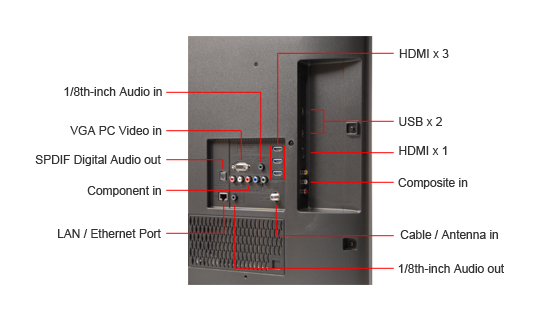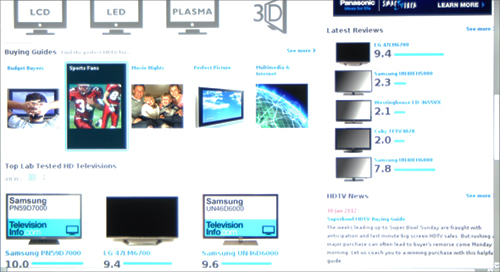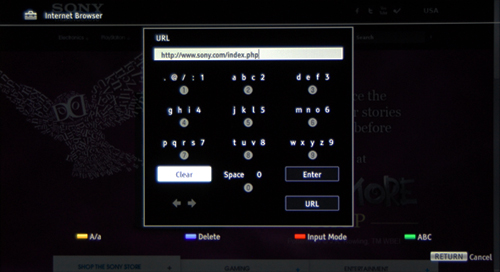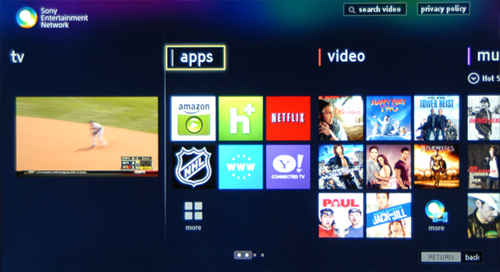The excitement of having online features is now just wearing off. We were ecstatic that a TV could be so much more than just a display for a cable box; something to connect to the internet and therefore the world!
Now that the fiery honeymoon period has fizzled to a dull glow, we have the clarity to judge these systems as they are. Some Smart TVs are incredibly useful. They provide the content and control to supplant our urge to use the tablet or Smartphone sitting next to us. Others, are clunky, slow, and confusing. The Smart TV label on these second types is merely a marketing feature, more type to put on a box, not more to offer the consumer.
The Sony Bravia KDL-40EX640 ($899 MSRP), is a 2012, low-end, 1080p Smart TV. We like that Sony has put out a cheaper Smart TV to give online features to the masses, but we don’t like their execution. Check out our Software and Internet section of the review to see how Sony has improved, but not quite perfected, their Smart TV interface.







Now that the fiery honeymoon period has fizzled to a dull glow, we have the clarity to judge these systems as they are. Some Smart TVs are incredibly useful. They provide the content and control to supplant our urge to use the tablet or Smartphone sitting next to us. Others, are clunky, slow, and confusing. The Smart TV label on these second types is merely a marketing feature, more type to put on a box, not more to offer the consumer.
The Sony Bravia KDL-40EX640 ($899 MSRP), is a 2012, low-end, 1080p Smart TV. We like that Sony has put out a cheaper Smart TV to give online features to the masses, but we don’t like their execution. Check out our Software and Internet section of the review to see how Sony has improved, but not quite perfected, their Smart TV interface.
Models in series (details)
Sony KDL-40EX640 40 inches
Sony KDL-46EX640 46 inches
Sony KDL-55EX640 55 inches
Design


Sony has taken up with the design aesthetic of providing only what you need. Once you have included everything functional, and stripped away all that is unnecessary, a design will feel complete, simple, sleek, and luxurious. This simplicity makes for a comely television that will fit nicely anywhere in your home.
The connectivity is similarly straight to the point, providing what you need in an uncreative layout that we find just to our liking.
The bezel is made of a stippled gray plastic material. This textured surface is not readily noticeable, so as to not be distracting, but when we tested the reflectivity we saw that it really cut down on the brightness of the bounce light. We feel this design foregrounds the display rather than attempts an overly modern style, or takes over a room with an industrial chunkiness.
The stand is unobtrusive, made of a thin sheet of black plastic, and connected to a heavy metal neck that swivels about 20º in either direction.
There are manual controls located out of sight on the right side of the display. There are grooves in the shape of a plus sign on both the volume and channel buttons that help you know where you are in the dark. The layout makes sense such that you will know exactly where the buttons are without having to look at them at all.
In the Box
In the box we found a television, a remote, batteries, a USB dock adapter, a WiFi adapter dongle, a manual, warranty documents, and a quick setup guide.
Remote Control

We could not be anything but disappointed with this remote. There is no way to emphasize enough that if you add advanced features to a television, you need to add advanced controls to a remote. How can the old remote possibly be useful for a brand new generation of television?
Now that we have seen new generations of remotes, clever devices using a full keyboard, or RF connectivity for a computer mouse-like experience, we can’t go back.
We could say things like, these buttons have excellent tactile feedback, and the weight of the remote is great, but who cares? This remote is responsible for much more than changing channels and it is just not up to the task. Lack of control hinders every feature of the Smart TV experience. When there are better remotes out there to help you cruise through the Smart TV world, why bother with something that doesn’t quite work?
Smart TV
The XMB interface is only offered on high-end TVs this year, but I didn't miss it because the simpler menus of the EX640 are even easier to use. The most-used apps are still within easy reach on the Menu page, and don't require booting into a new interface. From here you can access the big three: Amazon Instant, Hulu, and Netflix (Sony doesn't support Vudu). Of course, there is also the SEN (Sony Entertainment Network), should you also want access to the company's extensive movie and music offerings. Unfortunately we found that opening it was a very sluggish process -- the SEN interface took up to a minute to load.
Picture settings
For a midrange television the EX640 offers a good range of picture settings, even if the separate Scene modes are a bit buried in the menus. Unusually I found that the often-excellent Cinema scene mode wasn't as flexible as General, and hid access to the grayscale adjustments necessary for a good calibration.
Connectivity

Breadth and simplicity are what we like to see when checking out the connectivity on a TV. Sony has accomplished both of these by offering four HDMI ports, two USB ports, a component and composite each, several audio connections, and a cable connector.
Getting creative with the ports arrangement is never necessary, especially because it is covered up when looking at the TV from the front. Sony keeps this arrangement simple, using both a side cutout and a back panel. The labeling is all there, and the stand neck swivels for easy access. We like it.
The ports are all on the back or on a cutout on the left side of the display. The cutout on the side is for easy access. Sony gives you an HDMI port for quick hookup of game systems, a composite connection for AV devices and two USB ports for quick media demonstrations. These are just great placement decisions made by a veteran company in the television industry.
Software & Internet
The Sony Smart TV menus last year were a mess. They were reason alone not to buy a Smart TV from them. Generally, we like the performance on Sony TVs, but they could not get it together for the advanced features.
This year, we see some maturity. Rather than a frantically scatter-brained mishmash of online googaw, we see a no nonsense collection of all the Smart TV features in one menu called Home. You can open this menu with one push of a button on the remote. The menu has no animations, no bulging icons, no flashy colors. It looks like the settings menu on other TVs, and it is easy.
There is some backsliding however. The word apps is thrown about all over this TV and means two entirely different sets of features. The Sony Entertainment Network is an attempt to look like other successful Smart TV systems, but falls short in that it excludes much of the functionality that is readily available in the Home menu. It’s not a great system, but it’s certainly an improvement.
Interface

Rather than trying to keep the settings and the advanced features in the same convoluted menu system, the settings are now in a more standard interface. Pressing the Home button brings up a small menu on the bottom left side of the screen, where the bottommost option is settings. The settings menu opens up into a full screen transparency that works like every other settings menu we have seen.
This interface is a vast improvement over last year. Sony TVs from 2011 tried to borrow interface cues from the PS3, a device that won awards for menu design. The mechanical navigation of these menus was similar, however the menus themselves were a vast, winding maze of disorganization. Sony has scrapped this idea in favor of straight-forward text based menus.

In previous years, Sony could not figure out what they wanted to do with all their Smart TV content called apps. There were small pockets of online content located in several different menus, the organization of which did not make any sense to us. This year, Sony has attempted to take after other successful brands by creating a single interface with all – or in this case most – of the online features. By pressing the Home button on the remote, a small menu opens up on the bottom left side of the screen which gives you a quick, non-flashy look at all of the features contained here. This is really an improvement over previous years advanced features menu, but it is not customizable, so only the premium apps are featured here. Furthermore, this is not the only way to get to the online features, there are several buttons on the remote that bring you to limited functionality, like the SEN button which shows you a list of apps, but does not allow access to the Yahoo apps or the web browser.
Browser
The browser is barely usable. All you have at your disposal is a directional pad and the number keys to navigate the largest collection of information mankind has ever assembled. Typing in URLs is a pain. You have to type each number key enough times to get the right letter. There are no present .com or .org buttons on the screen, making the process even more tedious than it needs be. Selecting links within a website is another chore. The only way to navigate a page is to press the directional buttons until your link is highlighted, which can take a while and requires repeated button mashing.
Two years ago, we may have been charmed by a web browser on our TV. Now, we know it can be better than this inept interface. Sony has had plenty of time to come up with a creative solution to poor interface design, yet they have settled for the lowest common denominator. We have seen some excellent innovations from companies like Samsung and LG; new ideas that are essential to the new functionality of Smart TVs. It does not make sense that the old way of operating a TV should work for all of the new functions contained therein. We consider this a huge drawback to buying this television. If you want to spend the extra money for a Smart TV, why would you pay to have one that is hard to use?
Apps

The SEN has a front page where your video feed becomes a box next to an Apps section, a Video section, a Music section, and a Favorites section where you can customize your SEN content for quick access. The Apps section contains all of the premium streaming partners, like Netflix, Hulu Plus, Amazon Instant watch, and strangely no Vudu, a streaming video partner available on the Sony PS3. The Video section is a Sony pay-per-view service called Unlimited Video that certainly does not have unlimited videos. In fact, the service is not even ready yet. The Music section is a monthly fee service that allows you to listen to new music or a nice list of genre oriented radio stations right on your TV.

This is all well and good, but Sony uses the word apps to describe two entirely different sets of online features. First, there are the premium streaming partners that we discussed above, under the header “apps” in the SEN section of the online content. Then, there is the Internet Apps button on the remote, which opens up Yahoo Internet Apps, silly little items that appear as a bar along the bottom of the screen and provide information like the weather, stock fluctuation, and images from the Daily Puppy.

You cannot get to these apps from the SEN, nor can you get to the internet browser from there. All things are again located in different areas, this year the differences are just different from last year, in case you got used to the previously mismanaged interface.
One of the big marketing features is the ability to play games from your mobile media device up on your big screen. This includes your PSPs, which could be really cool played 40 inches big with no wires or other connections. Unfortunately, we did not have a Vita in our office, but we think you will enjoy this feature if you have portable Sony devices.
The USB media port works just fine. Plug in a USB compatible device and the Bravia KDL-40EX640 will recognize that there is playable content and bring you to a main menu. From here, you can select photos, video, or music from your device, with the ability to make a slideshow, using a mix of photos and music. You can control the transitions, the zoom, and the speed of the slides by clicking the options button on the remote. This Sony comes with a USB extender dock, making it easy to plug in devices like a Flip camera, or anything else with an attached USB connector.
Spaces
Manufacturer Sony
Part Number KDL-40EX640/US
General
Product type LED-LCD
Diagonal size 40 in
Features
Connectivity Wi-Fi ready, adapter included
Instant internet streaming services Sony Entertainment Network and apps access,
BRAVIA Internet Video
TV features On-screen menu,
Channel labeling,
Game mode,
LightSensor Technology,
Parental control,
Advanced Contrast Enhancer,
Digital Noise Reduction (DNR),
Sleep timer
Video
Technology LED-LCD
LCD backlight technology LED Backlight technology
LED backlight type Edge-lit
Resolution 1080p
Remote Control
Type Standard remote control
Features Scene Select
Sustainability
Greenpeace policy rating (Nov 2011) 3.6
Conclusion
The Bravia KDL-40EX640 ($899 MSRP) is a low-end, 1080p Smart TV from Sony in 2012. We like that they are producing a cheaper Smart TV, hitting a niche audience that wants online features, no 3D, and a good television.
The menu system and the performance are definitely acceptable. We saw great improvements in the Smart TV interface compared to Sony’s attempt at advanced features last year. The Home menu puts together everything you need in one easy-access list. In every one of the performance categories, we recorded reasonable numbers, making this TV of standard quality.
Within these brighter points, there are some drawbacks. Though the menu system has improved, it’s still not close to being the best. Online features are still spread about into different pockets, which are hard to access laterally. Every option must be exited to get to the next one. Furthermore, the remote has no more functionality than older remotes, making navigation all the more difficult. We have seen so many innovations on the remote, features that pander to Smart TV usability, that to give consumers anything less is just cop-out. Another down note is the flashlighting of the edgelights. Sony continuously has trouble with flashlighting artifacts, even in their top-tier models, and the Bravia KDL-40EX640 is yet another example.
In the end, we have a very average Smart TV that is not as easy to use as the better performing competition. Take a look at other models, and you will probably find something that better suits your needs.
